ABSTRACT
The spread of Coronavirus Disease-19 (COVID-19) in Korea made people stay at home, which yields that households reduce their frequency of going to supermarkets and grocery stores to buy foods and that many households make order delivery or take-out of foods instead of eating at restaurants. Korean Households were paid emergency disaster relief funds that are provided by the central and local governments for stabilizing household income and boosting local consumption. Our findings report that much of relief funds were used to purchase food at grocery stores and restaurants. In particular, it was found that it was widely used to purchase meat products such as beef and pork. Our analysis shows that the Korean government's emergency disaster relief funds helped consumption activities of households, which implies to have significantly restored households' purchase of agri-food products. Furthermore, given the value chain of the agricultural and food industry, the relief funds helped not only households but also the agriculture, forestry, livestock, food, and catering industry in general.
Keywords: COVID-19, Relief Fund, Food Consumption, Public Policy, Government Spending.
INTRODUCTION
After the first case of Coronavirus Disease-19 (COVID-19) in Korea was confirmed on January 20, 2020, the subsequent spread of the COVID-19 pandemic has surged, especially from February to March. On February 29, 2020, the number of newly confirmed cases of COVID-19 had reached 813, which is the highest in the newly confirmed cases before August. After that, the number of newly confirmed cases gradually decreased and had been stabilized at about 20 by mid-April. However, from the end of May 2020, the number of new COVID-19 cases had slightly increased as it spread nationwide.
Looking at the number of new cases in each quarter, the spread of COVID-19 in the first quarter of 2020 was more severe than in the next quarter. The total number of newly confirmed COVID-19 cases was 9,786 and 3,013, respectively, in the first and second quarters of 2020.
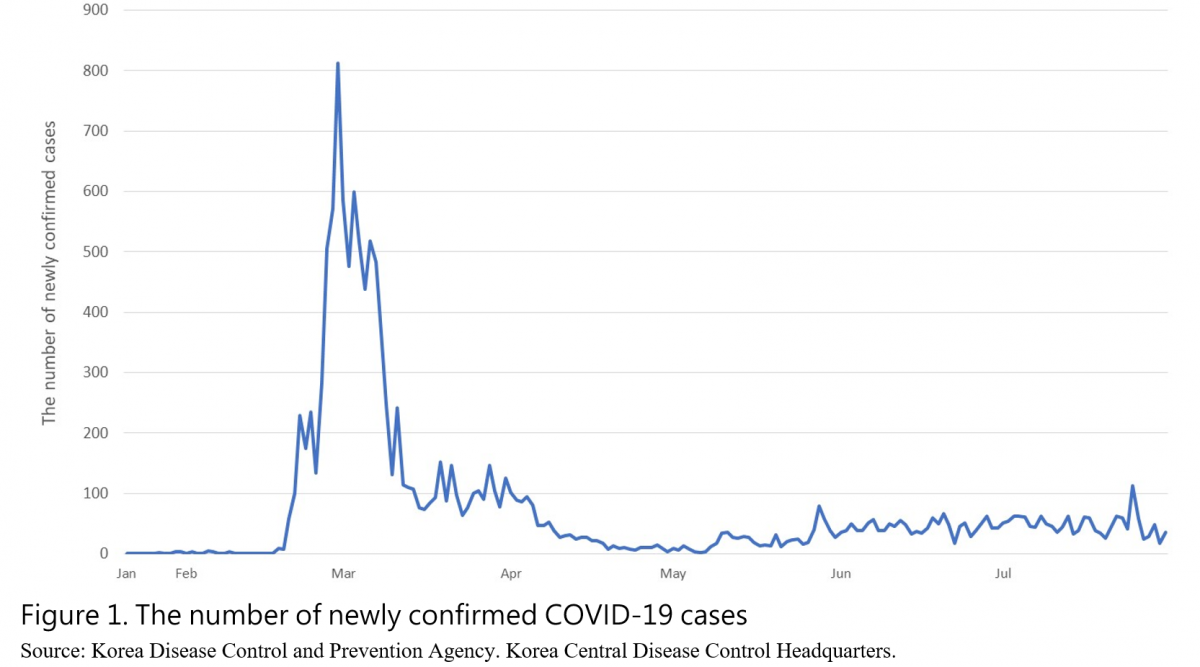
The spread of the COVID-19 pandemic in Korea made people stay at home, which yields that households reduce their frequency of visiting supermarkets and grocery stores to buy foods and that many households make order delivery or take-out of foods instead of eating at restaurants.
Korean households were paid emergency disaster relief funds that were provided by the central and local governments for stabilizing household income and boosting local consumption. The relief funds were paid out to a total of 21.71 million households across the country. It is expected that the relief funds provide an opportunity to revitalize the local economy that has been stagnated due to the COVID-19 virus. As such, there is an argument that the provision of relief funds contributed to revitalizing the local economy by expanding household consumption. However, some argued that consumers who received the relief funds would not have increased consumption.
This study attempts to measure the impact of the emergency disaster relief funds on food consumption. In terms of food consumption policy, it is very important to figure out how much of the relief funds were used for the food sector (food consumption). It has an important meaning in terms of providing a background study not only on the effectiveness of the current response measures against the COVID-19 but also on responding to a potential situation like the COVID-19 pandemic in the future. For food consumption policies in response to the COVID-19 pandemic, it could be a very important policy issue to investigate how much impact the payment of the disaster relief funds would have had on the revitalization of agri-food consumption. In order to analyze the effect of the disaster relief funds on agri-food consumption, we analyzed economic conditions and consumption behaviors of households, based on Statistics of Korea’s economically active population survey, and household income and expenditure survey. We also conducted an online survey on Korean households’ receiving and use of the disaster relief funds from August 27 to September 4, 2020.
HOUSEHOLD ECONOMY AFTER THE COVID-19: EMPLOYMENT, INCOME, AND CONSUMPTION
Employment
The economic conditions of households appear to have deteriorated as the number of domestic workers in March and April 2020 decreased. In March and April 2020, the number of seasonally adjusted employment decreased across all types of employment compared to the previous month. In particular, temporary employees in March and in April 2020 decreased by 7.6% and 2.1% from the previous months, respectively, showing a more serious decline compared to other types of employment. During the same period, the number of daily employed workers also decreased significantly. In March and April, it decreased by 5.19% and 5.24%, respectively. Even the number of regular employees decreased by 0.50% and 0.98% in March and April, respectively, from the previous month.
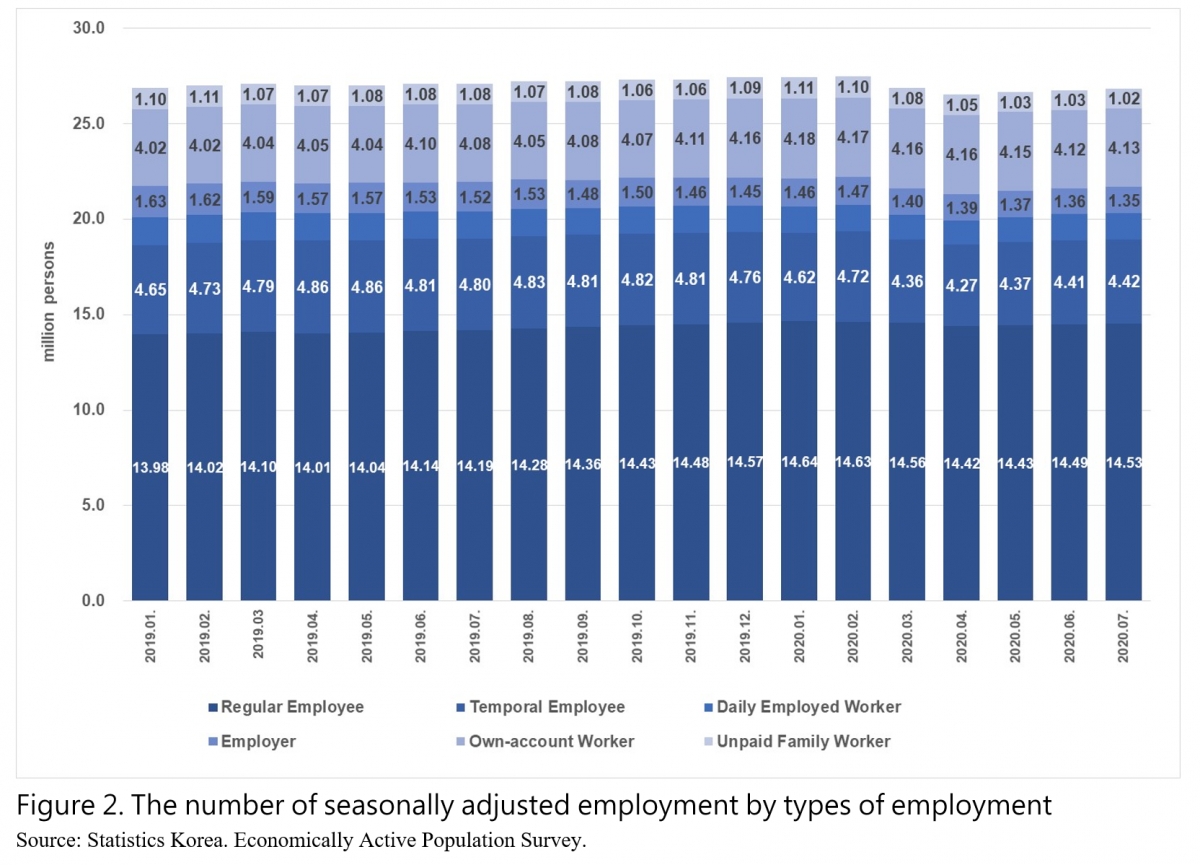
Household Income
Looking at the monthly average disposable income for salary and wage earners’ households, the average was found to have increased significantly in the first quarter of 2020 (KRW 4.738 million, USD[1] 4,120 ) compared to the fourth quarter of 2019 (KRW 4.241 million, USD 3,687). However, we can see that the disposable income of the group under KRW 6 million (USD 5,217 ), excluding the income range of KRW 4-5 million (USD 3,478-4,347) decreased compared to before the outbreak of COVID-19 when breaking it down by income level. In particular, the disposable income of the group under KRW 2 million (USD 1,740 ) decreased significantly, which indirectly indicates that the likelihood of low-income households has deteriorated due to the COVID-19 pandemic.

Table 2 shows the monthly average disposal income of other households. The averages of disposable income for others (not for salary and wage earners) were KRW 3.383 million (USD 2,942 ) in the fourth quarter of 2019 and KRW 3.238 million (USD 2,816) in the first quarter of 2020, suggesting that those consumption conditions have deteriorated since the COVID-19 pandemic. For self-ownership and the unemployed households, monthly average disposable incomes fell in all income levels except for KRW 1-1.99 million (USD 870-1,739) and KRW 7 million (USD 6,087 ) and higher.
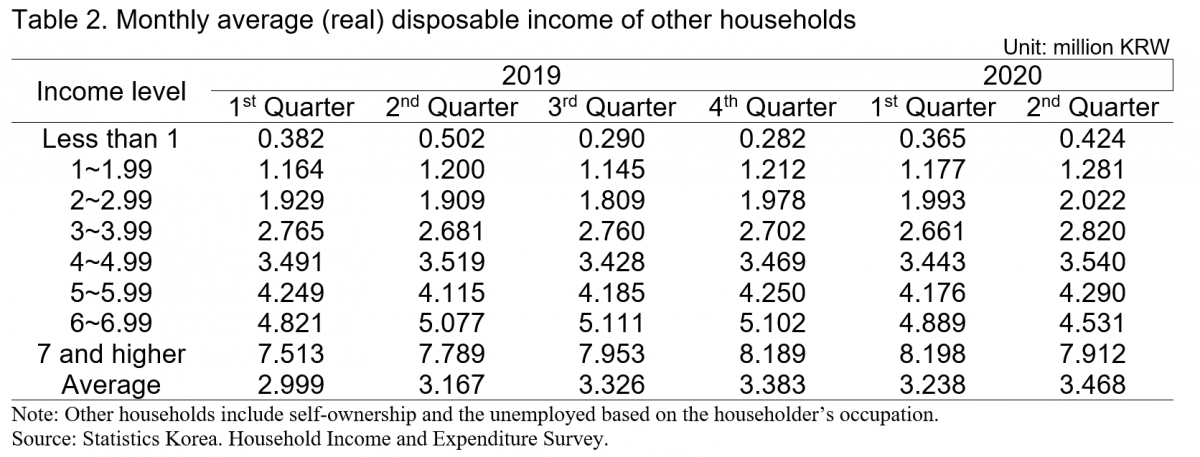
Consumption Index
The Consumer Survey Index (CSI)[2] since January 2019 showed a recovery trend, beyond 100 at 101.7 in May 2019, and then declined again at 92.4 in September. Entering the fourth quarter of 2019, the CSI recovered and reached 104.2 in February 2020. However, due to the COVID-19 pandemic, it fell sharply to 96.9 in March, 78.4 in April, and 70.8 in May.
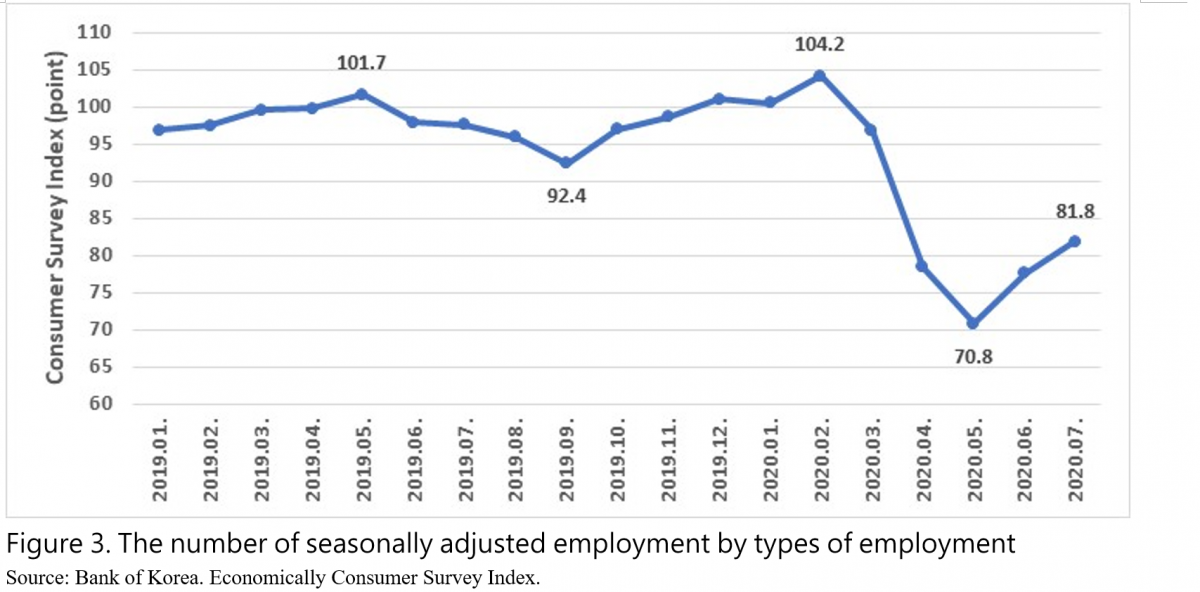

THE CHANGES IN CONSUMPTION BEHAVIOR OF KOREAN HOUSEHOLDS AFTER THE COVID-19
Table 3 reports that households tend to refrain from going out and spend more time at home as the COVID-19 pandemic spreads. About 81.3% of households have reduced going out after the COVID-19 outbreak (37.6% for the vast decrease and 43.7% for the decrease). 84.1% of households said that they spent more time at home due to the outbreak of COVID-19 (44.8% for the increase and 39.3% for the vast increase).

Since the COVID-19 pandemic, households reduced the number of times they buy foods from offline conventional stores such as grocery stores and traditional markets, the number of times eating at restaurants. Conversely, it appears that households have increased the number of purchasing foods through online shopping malls and the number of orders for delivery or take-out foods.
Table 4 shows that 51.9% of households said that they reduced the number of times they got food at offline stores after the COVID-19 outbreak (9.5% of vast decrease and 42.4% of decrease). Meanwhile, 46.7% of households said that they increased the number of times they bought groceries from online stores (40.1% of increase and 6.6% of vast increase). This implies that consumers are reluctant to go out and have shifted their grocery purchases from offline to online stores. Among the households surveyed, 46.4% said that they consumed delivery food at a similar frequency as before, and 42.3% said that they increased the number of delivery food orders compared to the pre-COVID-19 pandemic. Also, 53.8% said that they consumed takeout food at a similar frequency as before, and 31.9% said that they increased the number of takeout orders after the outbreak of COVID-19.
After the outbreak of the COVID-19 pandemic, in the case of food away from home, 73.6% of the households responded that they had reduced the number of meals at restaurants. Some companies quickly responded to these changes in consumer behavior and seized the opportunity, and those that failed to do so faced a crisis.
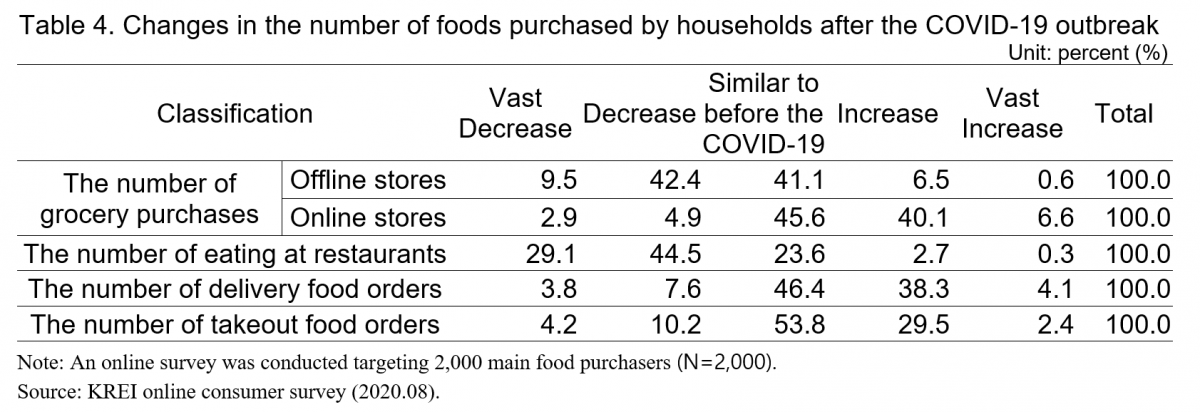
THE HOUSEHOLDS’ RECEIVING OF THE EMERGENCY DISASTER RELIEF FUNDS
Korean Households were paid emergency disaster relief funds that are provided by central and local governments for stabilizing household income and boosting local consumption. The central government’s funds were paid out to a total of 21.71 million households nationwide regardless of income. They are based on the number of household members: KRW 400,000 (USD 344) for single-person households, KRW 600,000 (USD 516) for two-person households, KRW 800,000 (USD 688) for three-person households, and KRW one million (USD 859) for households with four or more members (Government of the Republic of Korea. 2020).
Most of the households received the emergency disaster relief funds from the central government in full. Some eligible households asked government agencies to donate them for others instead of taking them. Our survey reports that 97.7% of households received the full central government relief funds and 76.4% received the full amount of local government relief funds. The proportions of full donation to each relief fund were 0.7% and 5.7%, respectively, and there were more cases where local government relief funds were donated compared to central government relief funds.

Our online consumer survey result also shows that most households received the relief funds from the central government and local governments between May and June. By the end of July, all households had received the relief funds. The Korean government tried to distribute the relief funds as quickly as possible to increase the effectiveness of the policy. For the relief funds that were paid by the central government, 59.5% of households received them by the end of May and 90.1% had them by the end of June. In the case of the local government's relief funds, payments were slightly later than those of the central government. As of the end of May, 57.6% of households had been paid the local government relief funds, and 88.3% had received them by the end of June.


Table 6 suggests that many households applied for the relief funds in the form of credit and debit card points. Among the households that received the central government relief funds, 66.1% received them by credit and debit card points, and the rest received prepaid cards (13.2%), gift cards (7.8%), and cash (12.9%). In the case of local government relief funds, 45.9% of households received the local relief funds in credit and debit card points and followed by prepaid cards (36.8%), gift certificates (8.6%), and cash (8.7%).

THE CHANGE IN HOUSEHOLDS’ CONSUMPTION BEHAVIORS AFTER RECEIVING THE EMERGENCY DISASTER RELIEF FUNDS
As discussed earlier, the COVID-19 outbreak worsened the employment situation (reducing the number of employed people), led to reducing household disposable income, and lowering consumers’ willingness to purchase (CSI). The Korean government has provided emergency disaster relief funds to all households to respond to this national economic downturn. Then, how did household consumption behavior change with the relief funds? In this section, we examine how the consumption behavior of Korean households has changed after they received the emergency disaster relief funds.
The change in household expenditure
Figure 5 shows the number of general purchases of private credit cards. It shows a recovery trend of the number of general purchases after May 2020, when disaster relief funds were paid.[3] The number of private credit card general purchases, which fell sharply to 980 million in February 2020, slightly increased to 1,002 million in March and 1,004 million in April. However, it started to recover from May 2020 (1,101 million).


The general purchase amount of private credit card use started to show a recovery from May 2020. It decreased significantly to KRW 33.5 trillion (USD 29.1 billion) in February, which was the same in March. In April, it increased to KRW 34.3 trillion (USD 29.8 billion). Although it increased by 2.4% from March, it was far below the KRW 38.4 trillion (USD 33.4 billion) in January. Then, in May 2020, it significantly inclined to KRW 37.9 trillion (USD 33.0 billion). This is very similar to the previous year, 2019.
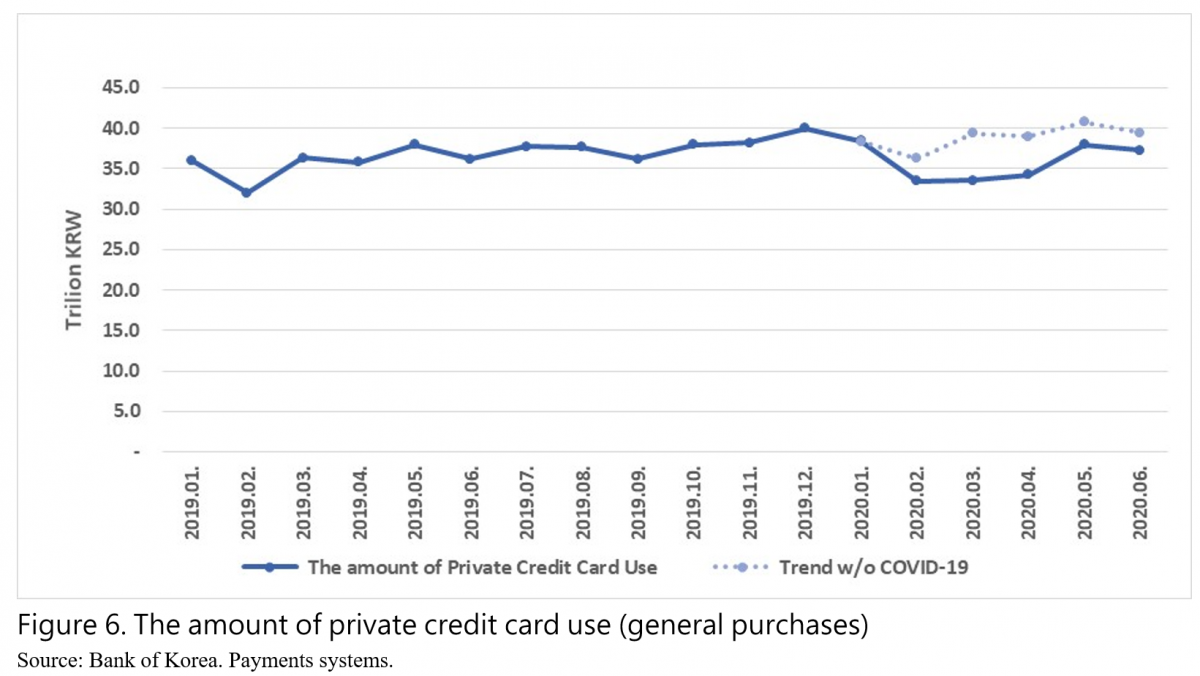

The total relief fund paid by credit and debit card points was KRW 9,617.6 billion (USD 8,363 million). 99.4% of the credit and debit card points (KRW 9,559.1 billion, USD 8,312 million), was used. In particular, 91% of the credit and debit card points were used in May and June. The credit and debit card points of KRW 5.702.3 trillion, 59.7%, (USD 4,958 million) were used in May when relief funds began to be paid out, and KRW 3.43 trillion, 31.4%, (USD 2,612 million) were used in June.

The use of the emergency disaster relief funds
According to the press release by Korea Ministry of the Interior and Safety, about half of the credit and debit card points were used in the 'mart/grocery' business and the 'restaurant' business. About KRW 2.5 trillion, 29.08%, (USD 2,186 million) of credit and debit card points for the relief funds, was used in the 'mart/grocery' business, and KRW 2.3 trillion, 26.89%, (USD 2,022 million) was used in the 'restaurant' business. In addition, the relief funds paid as credit and debit card points at ‘convenience stores’ and ‘bakeries’ amounted to KRW 569.9 billion (USD 495.6 million), accounting for about 6.6% of credit and debit card points for the emergency disaster relief funds.
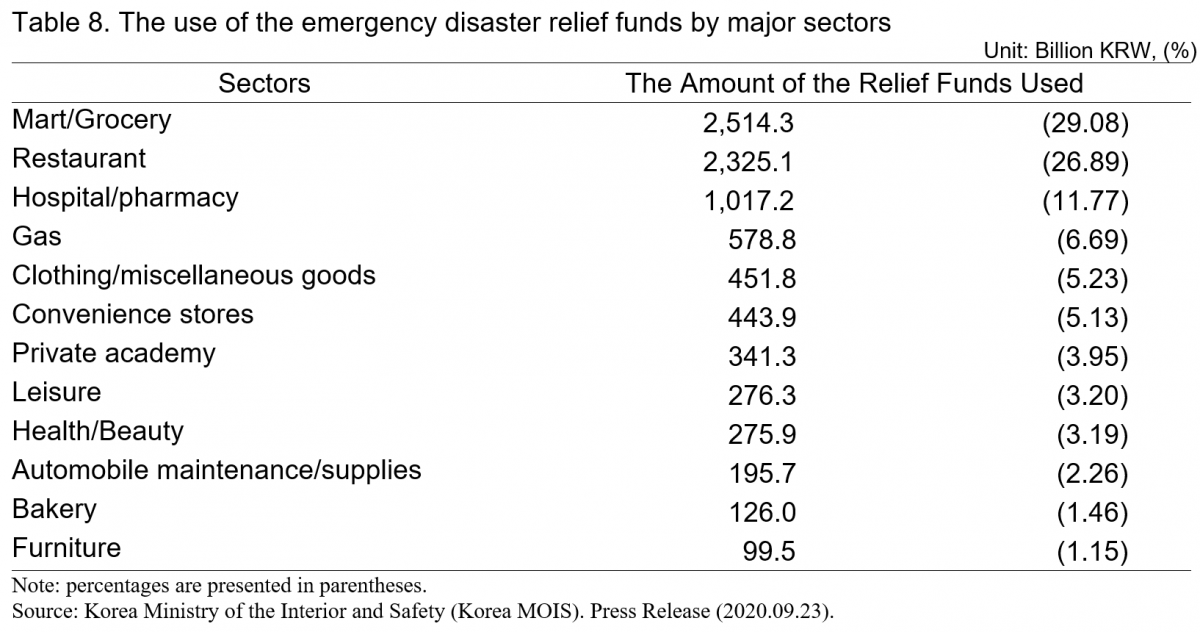
The change in agri-food purchases
Figure 7 illustrates that after receiving the relief funds, households slightly increased the number of times they bought groceries at stores such as marts and traditional markets. 42.9% of the households answered that they bought more groceries from offline stores after receiving the relief funds than before it. On the other hand, 28.3% of households surveyed answered that they bought more groceries from online stores after receiving the relief funds than before it. 57.8% answered that they bought groceries online a similar number of times as before it. Therefore, it is thought that the number of times households bought groceries at offline stores increased more than the number of times that households purchased groceries at online stores after receiving the relief funds.
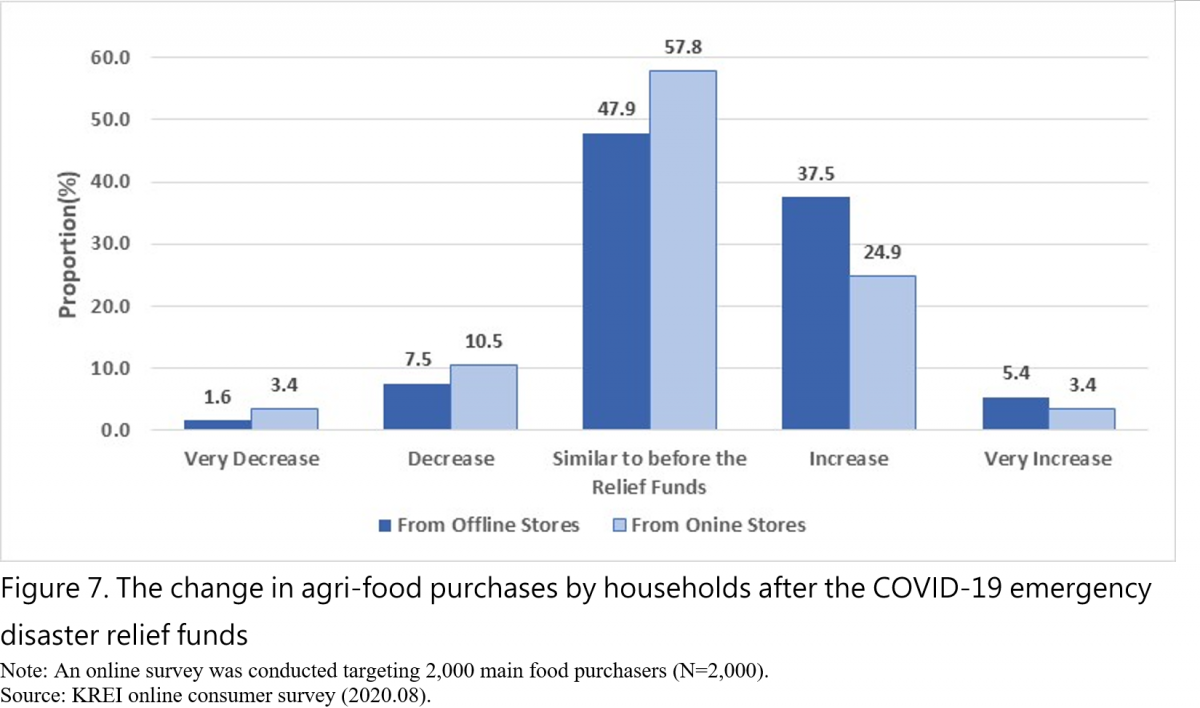
We investigated changes by agri-food items among households that received the relief funds. The questionnaire was conducted on a 5-point Likert scale. A point of 1 means a "vast decrease," a point of 2 means "decrease". A point of 3 indicates "the same as before the relief fund". Points of 4 and 5 refer to "increase" and "vast increase," respectively. The results are presented here as an average. As a result of examining the change in purchase volume by agri-food item on a 5-point scale, it was found that households receiving disaster aid increased their purchases mainly of pork and beef among meats. After receiving the relief funds, the average change in the amount of pork purchase was the highest at 3.38, followed by beef (3.31), eggs (3.28), chicken (3.23), and milk (3.18).
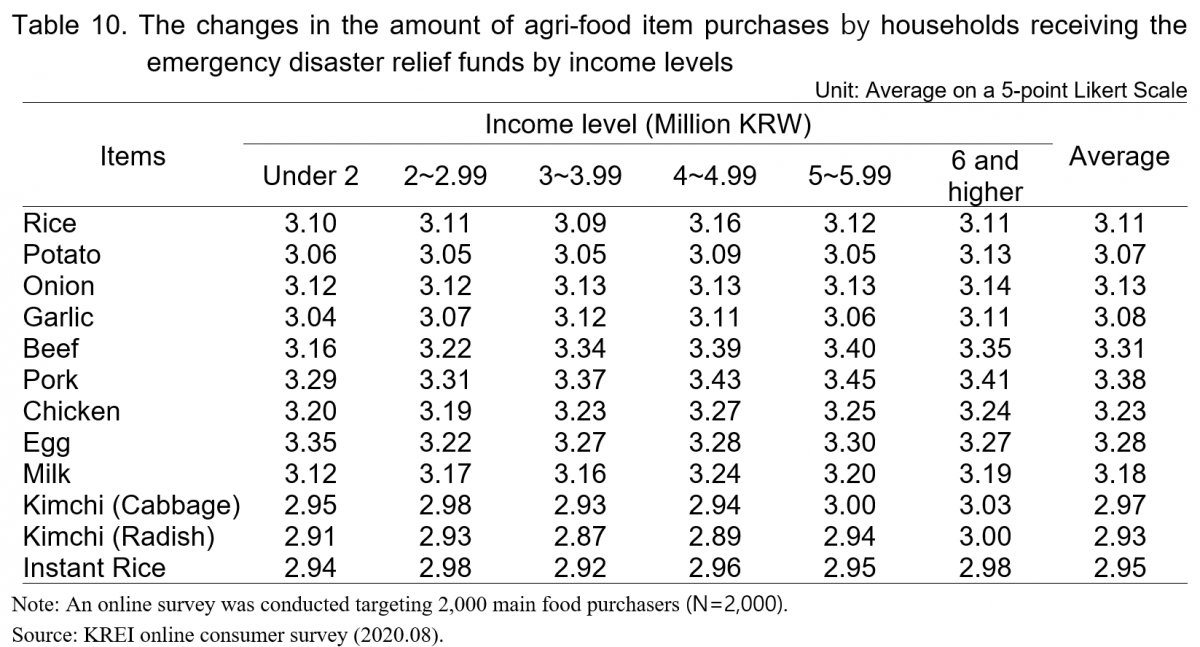
The change in food service use
Figure 7 describes that households increased their food service use to get foods after receiving the relief funds across food service types. 27.0% (25.3%+1.7%) of households said that they increased their meals, although 24.1% (16.9% + 7.2%) answered that they reduced their having meals at restaurants. 49.0% of households said that they ate out at a restaurant the same number of times as before the relief funds.
For the delivery food orders, after receiving the relief funds, 39.0% (35.3% + 3.7%) of households answered that they ordered more delivery food than before the relief funds, and 54.2% responded that they ordered delivery of food the same number of times as before. Only 6.8% (2.8% + 4.0%) reduced their delivery food orders. In addition, for the change in take-out foods, 32.6% (29.3% + 3.3%) of households answered that they increased the number of take-out orders of foods after the relief funds, compared to before. 59.6% answered that they placed a take-out order similar to the number before. Only 7.8% (2.7% + 5.1%) said they reduced their orders for take-out foods.[4]
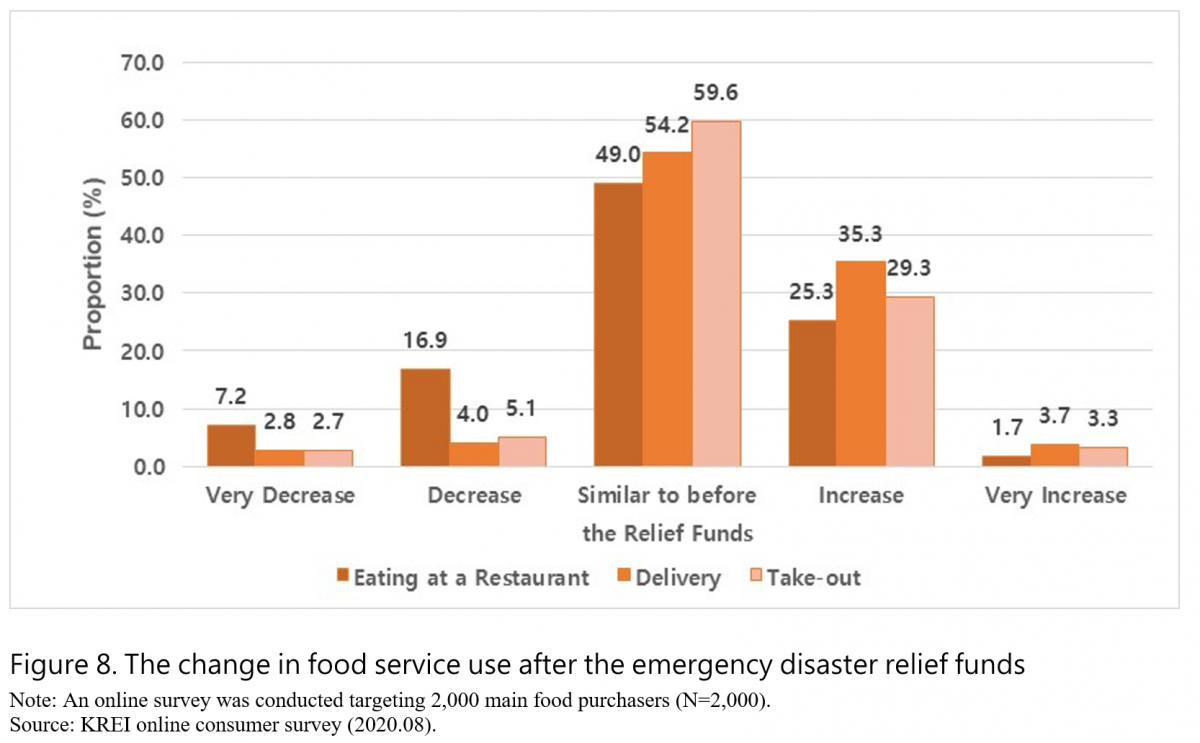

RECOGNITION AND EVALUATION OF THE EMERGENCY DISASTER RELIEF FUNDS
We conducted an online survey to find out how Korean households perceived the emergency disaster relief funds. The questions are composed of a 5-point Likert scale, and the results are presented by income level as shown in Table 10. Overall, Korean households tend to strongly agree that the relief funds not only help the household economy but also support and ensure food and drinks for low-income households.
The average point of the question 'The relief funds contribute to household economic activities ' was 4.11 points. Here, households with an average monthly household income of less than KRW 2 million (USD 1,740) gave 4.14, whereas those with an average monthly household income of KRW 6 million (USD 5,217) and higher assessed 3.98.
The average point of the question 'The relief funds help to ensure the diet/food for the low-income households' was 4.09 points. The average points of this question seem to be similar across household income levels (4.06-4.14).
In response to the question 'The relief funds help to ensure the diet/food for all the people', the point for households with an average monthly household income of less than KRW 2 million (USD 1,740) was 3.93. Whereas, for households with an average monthly household income of KRW 6 million (USD 5,217) or more, the point was higher at 3.74. From this point of view, it is thought that the lower-income households perceive that the relief funds are helping to ensure food and drinks.
Our survey result suggests that households recognized that relief fund is an essential role of the government in a situation such as the COVID-19. The average point of the question 'The relief fund an essential government role under the COVID-19' was 3.78. They also believe that it is helpful to agri-food industries and restaurant business. For the questions 'It helps agri-food industries' and ‘It helps restaurant business, the average points were 3.92 and 3.94, respectively.
As for the payment method, survey results report that high-income households believe that disaster assistance should be provided in local currency or local gift certificates rather than cash, which is the opposite opinion of the low-income households. For the question of 'the relief funds should be provided in local currency or local gift certificate rather than cash', the score for households with an average monthly household income of less than KRW 2 million (USD 1,740) was 3.18, whereas, for households with an average monthly household income of KRW 6 million (USD 5,217) and higher, the score appeared as 3.69 points.
Considering that low-income households are more vulnerable to the COVID-19, it seems that low-income households want more cash aid. This is thought to be because, from the perspective of low-income households, cash-type support can be used for more diverse purposes, such as monthly rent and loan interest payments.
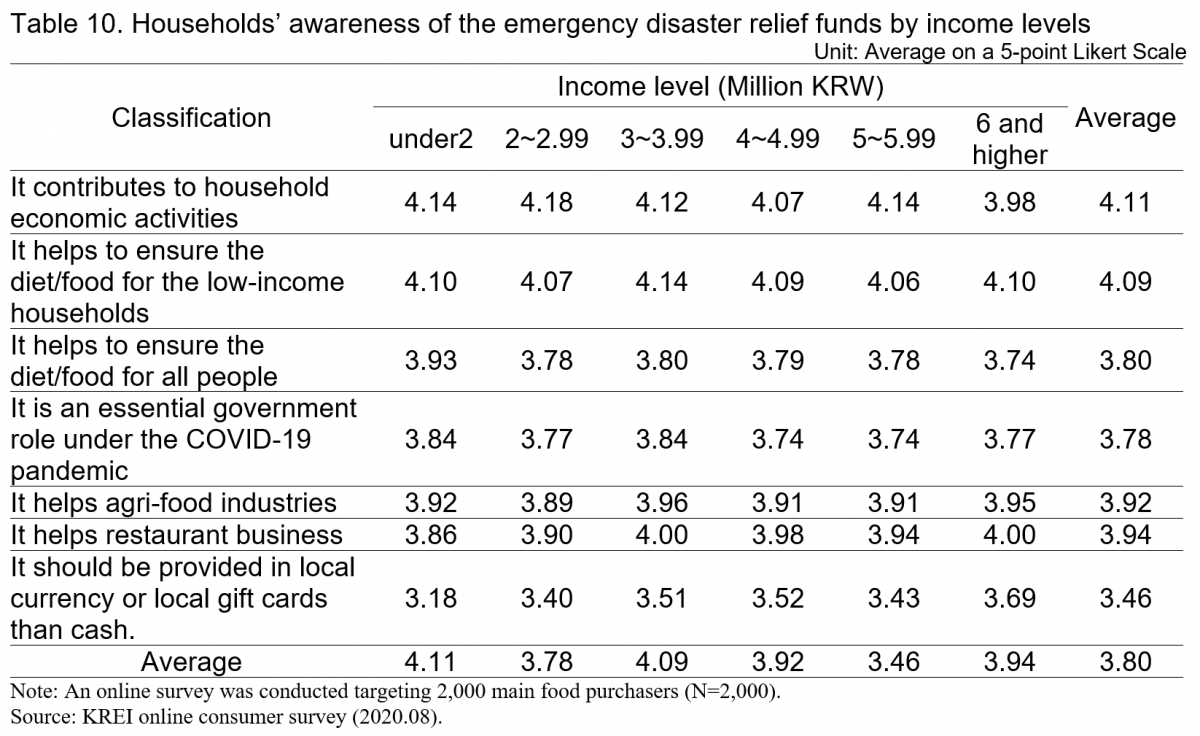
CONCLUSION
This analysis tried to understand the effect of the emergency disaster relief funds in terms of agri-food consumption. Specifically, we looked at changes in household economic conditions and consumption behaviors following the emergency disaster subsidy along with the nationwide spread of the COVID-19 pandemic. In addition, this analysis compares and analyzes changes in the consumption of agri-food by households receiving emergency disaster subsidies. We summarize the main results as follows.
The government’s emergency disaster relief funds were paid to most of the Korean households between May and June 2020, in the form of credit and debit card points that is the largest portion of the payment methods. It is thought that the funds were effective in alleviating the deterioration of household economic conditions due to the spread of the COVID-19 virus. After the disaster subsidy was paid, the number of personal credit card purchases showed a recovery trend, and the number of households purchasing groceries at offline stores such as superstores and traditional markets increased. However, the number of households eating out (meals in restaurants) did not increase significantly. The amount of personal credit card purchases began to show a recovery trend. About half of the relief funds were used in the 'superstores/food' business and the 'restaurant' business, which indicates that the funds were used for daily purchases of food, eating-out, gas, and private education.
In terms of agri-food consumption, the analysis showed that the funds have an effect on increasing households' expenditure for meat consumption. In particular, our analysis reports that the households that were paid the relief funds increased their meat consumption, mainly pork and beef. In addition, the analysis also showed that the relief funds led households with a high percentage of grocery purchases at online stores to buy agri-food from offline stores.
On the other hand, our survey results report that households strongly agree that the relief funds not only helped household economic activities but also supported ensuring food and drink for the vulnerable. In addition, households perceive that relief funds play an essential role in the government in situations such as the COVID-19 pandemic.
In conclusion, the results of this study suggest that the relief funds not only alleviated the decrease in household disposable income due to the COVID-19 pandemic by increasing households' public transfer income but also had an effect on revitalizing household consumption. In particular, the analysis revealed that the relief funds had a positive effect in terms of activating agri-food consumption.
REFERENCES
Bank of Korea. Payments systems.
Bank of Korea. Economically Consumer Survey Index.
Government of the Republic of Korea. 2020. All about Korea’s Response to COVID-19. Task Force for Tackling COVID-19, the Ministry of Foreign Affairs, Republic of Korea.
Korea Disease Control and Prevention Agency. Korea Central Disease Control Headquarters.
Korea Ministry of the Interior and Safety (Korea MOIS). Press Release. 2020.09.23. Government Emergency Relief Fund completes payment of 14,235.7 billion KRW to 22.16 million households nationwide.
Statistics Korea. Household Income and Expenditure Survey.
Statistics Korea. Economically Active Population Survey.
[1] All US dollar (USD) conversions of Korea won (KRW) unit amounts are based on 1,150 KRW per USD.
[2] The Consumer Survey Index (CSI) is an index synthesized by standardizing six major individual indices in Korea's household sector: current living conditions, living conditions prospects, household income prospects, consumption spending forecasts, current economic judgment, and future economic prospects. It is provided by the Bank of Korea.
[3] This period is also when the number of the newly confirmed COVID-19 cases was relatively low. Therefore, we would like to note that we do not make an argument that the increase in the number of private credit card use is entirely the effect of the relief funds.
[4] After COVID-19, mobile food ordering systems in Korea have significantly developed, resulting in a huge increase in delivery and take-out orders for foods. This trend may have been partially reflected in the change in food service use. So, we would like to note that it is not a net effect of the relief funds on the change in food service use.


COVID-19 Relief Funds and Food Consumption
ABSTRACT
The spread of Coronavirus Disease-19 (COVID-19) in Korea made people stay at home, which yields that households reduce their frequency of going to supermarkets and grocery stores to buy foods and that many households make order delivery or take-out of foods instead of eating at restaurants. Korean Households were paid emergency disaster relief funds that are provided by the central and local governments for stabilizing household income and boosting local consumption. Our findings report that much of relief funds were used to purchase food at grocery stores and restaurants. In particular, it was found that it was widely used to purchase meat products such as beef and pork. Our analysis shows that the Korean government's emergency disaster relief funds helped consumption activities of households, which implies to have significantly restored households' purchase of agri-food products. Furthermore, given the value chain of the agricultural and food industry, the relief funds helped not only households but also the agriculture, forestry, livestock, food, and catering industry in general.
Keywords: COVID-19, Relief Fund, Food Consumption, Public Policy, Government Spending.
INTRODUCTION
After the first case of Coronavirus Disease-19 (COVID-19) in Korea was confirmed on January 20, 2020, the subsequent spread of the COVID-19 pandemic has surged, especially from February to March. On February 29, 2020, the number of newly confirmed cases of COVID-19 had reached 813, which is the highest in the newly confirmed cases before August. After that, the number of newly confirmed cases gradually decreased and had been stabilized at about 20 by mid-April. However, from the end of May 2020, the number of new COVID-19 cases had slightly increased as it spread nationwide.
Looking at the number of new cases in each quarter, the spread of COVID-19 in the first quarter of 2020 was more severe than in the next quarter. The total number of newly confirmed COVID-19 cases was 9,786 and 3,013, respectively, in the first and second quarters of 2020.
The spread of the COVID-19 pandemic in Korea made people stay at home, which yields that households reduce their frequency of visiting supermarkets and grocery stores to buy foods and that many households make order delivery or take-out of foods instead of eating at restaurants.
Korean households were paid emergency disaster relief funds that were provided by the central and local governments for stabilizing household income and boosting local consumption. The relief funds were paid out to a total of 21.71 million households across the country. It is expected that the relief funds provide an opportunity to revitalize the local economy that has been stagnated due to the COVID-19 virus. As such, there is an argument that the provision of relief funds contributed to revitalizing the local economy by expanding household consumption. However, some argued that consumers who received the relief funds would not have increased consumption.
This study attempts to measure the impact of the emergency disaster relief funds on food consumption. In terms of food consumption policy, it is very important to figure out how much of the relief funds were used for the food sector (food consumption). It has an important meaning in terms of providing a background study not only on the effectiveness of the current response measures against the COVID-19 but also on responding to a potential situation like the COVID-19 pandemic in the future. For food consumption policies in response to the COVID-19 pandemic, it could be a very important policy issue to investigate how much impact the payment of the disaster relief funds would have had on the revitalization of agri-food consumption. In order to analyze the effect of the disaster relief funds on agri-food consumption, we analyzed economic conditions and consumption behaviors of households, based on Statistics of Korea’s economically active population survey, and household income and expenditure survey. We also conducted an online survey on Korean households’ receiving and use of the disaster relief funds from August 27 to September 4, 2020.
HOUSEHOLD ECONOMY AFTER THE COVID-19: EMPLOYMENT, INCOME, AND CONSUMPTION
Employment
The economic conditions of households appear to have deteriorated as the number of domestic workers in March and April 2020 decreased. In March and April 2020, the number of seasonally adjusted employment decreased across all types of employment compared to the previous month. In particular, temporary employees in March and in April 2020 decreased by 7.6% and 2.1% from the previous months, respectively, showing a more serious decline compared to other types of employment. During the same period, the number of daily employed workers also decreased significantly. In March and April, it decreased by 5.19% and 5.24%, respectively. Even the number of regular employees decreased by 0.50% and 0.98% in March and April, respectively, from the previous month.
Household Income
Looking at the monthly average disposable income for salary and wage earners’ households, the average was found to have increased significantly in the first quarter of 2020 (KRW 4.738 million, USD[1] 4,120 ) compared to the fourth quarter of 2019 (KRW 4.241 million, USD 3,687). However, we can see that the disposable income of the group under KRW 6 million (USD 5,217 ), excluding the income range of KRW 4-5 million (USD 3,478-4,347) decreased compared to before the outbreak of COVID-19 when breaking it down by income level. In particular, the disposable income of the group under KRW 2 million (USD 1,740 ) decreased significantly, which indirectly indicates that the likelihood of low-income households has deteriorated due to the COVID-19 pandemic.
Table 2 shows the monthly average disposal income of other households. The averages of disposable income for others (not for salary and wage earners) were KRW 3.383 million (USD 2,942 ) in the fourth quarter of 2019 and KRW 3.238 million (USD 2,816) in the first quarter of 2020, suggesting that those consumption conditions have deteriorated since the COVID-19 pandemic. For self-ownership and the unemployed households, monthly average disposable incomes fell in all income levels except for KRW 1-1.99 million (USD 870-1,739) and KRW 7 million (USD 6,087 ) and higher.
Consumption Index
The Consumer Survey Index (CSI)[2] since January 2019 showed a recovery trend, beyond 100 at 101.7 in May 2019, and then declined again at 92.4 in September. Entering the fourth quarter of 2019, the CSI recovered and reached 104.2 in February 2020. However, due to the COVID-19 pandemic, it fell sharply to 96.9 in March, 78.4 in April, and 70.8 in May.
THE CHANGES IN CONSUMPTION BEHAVIOR OF KOREAN HOUSEHOLDS AFTER THE COVID-19
Table 3 reports that households tend to refrain from going out and spend more time at home as the COVID-19 pandemic spreads. About 81.3% of households have reduced going out after the COVID-19 outbreak (37.6% for the vast decrease and 43.7% for the decrease). 84.1% of households said that they spent more time at home due to the outbreak of COVID-19 (44.8% for the increase and 39.3% for the vast increase).
Since the COVID-19 pandemic, households reduced the number of times they buy foods from offline conventional stores such as grocery stores and traditional markets, the number of times eating at restaurants. Conversely, it appears that households have increased the number of purchasing foods through online shopping malls and the number of orders for delivery or take-out foods.
Table 4 shows that 51.9% of households said that they reduced the number of times they got food at offline stores after the COVID-19 outbreak (9.5% of vast decrease and 42.4% of decrease). Meanwhile, 46.7% of households said that they increased the number of times they bought groceries from online stores (40.1% of increase and 6.6% of vast increase). This implies that consumers are reluctant to go out and have shifted their grocery purchases from offline to online stores. Among the households surveyed, 46.4% said that they consumed delivery food at a similar frequency as before, and 42.3% said that they increased the number of delivery food orders compared to the pre-COVID-19 pandemic. Also, 53.8% said that they consumed takeout food at a similar frequency as before, and 31.9% said that they increased the number of takeout orders after the outbreak of COVID-19.
After the outbreak of the COVID-19 pandemic, in the case of food away from home, 73.6% of the households responded that they had reduced the number of meals at restaurants. Some companies quickly responded to these changes in consumer behavior and seized the opportunity, and those that failed to do so faced a crisis.
THE HOUSEHOLDS’ RECEIVING OF THE EMERGENCY DISASTER RELIEF FUNDS
Korean Households were paid emergency disaster relief funds that are provided by central and local governments for stabilizing household income and boosting local consumption. The central government’s funds were paid out to a total of 21.71 million households nationwide regardless of income. They are based on the number of household members: KRW 400,000 (USD 344) for single-person households, KRW 600,000 (USD 516) for two-person households, KRW 800,000 (USD 688) for three-person households, and KRW one million (USD 859) for households with four or more members (Government of the Republic of Korea. 2020).
Most of the households received the emergency disaster relief funds from the central government in full. Some eligible households asked government agencies to donate them for others instead of taking them. Our survey reports that 97.7% of households received the full central government relief funds and 76.4% received the full amount of local government relief funds. The proportions of full donation to each relief fund were 0.7% and 5.7%, respectively, and there were more cases where local government relief funds were donated compared to central government relief funds.
Our online consumer survey result also shows that most households received the relief funds from the central government and local governments between May and June. By the end of July, all households had received the relief funds. The Korean government tried to distribute the relief funds as quickly as possible to increase the effectiveness of the policy. For the relief funds that were paid by the central government, 59.5% of households received them by the end of May and 90.1% had them by the end of June. In the case of the local government's relief funds, payments were slightly later than those of the central government. As of the end of May, 57.6% of households had been paid the local government relief funds, and 88.3% had received them by the end of June.
Table 6 suggests that many households applied for the relief funds in the form of credit and debit card points. Among the households that received the central government relief funds, 66.1% received them by credit and debit card points, and the rest received prepaid cards (13.2%), gift cards (7.8%), and cash (12.9%). In the case of local government relief funds, 45.9% of households received the local relief funds in credit and debit card points and followed by prepaid cards (36.8%), gift certificates (8.6%), and cash (8.7%).
THE CHANGE IN HOUSEHOLDS’ CONSUMPTION BEHAVIORS AFTER RECEIVING THE EMERGENCY DISASTER RELIEF FUNDS
As discussed earlier, the COVID-19 outbreak worsened the employment situation (reducing the number of employed people), led to reducing household disposable income, and lowering consumers’ willingness to purchase (CSI). The Korean government has provided emergency disaster relief funds to all households to respond to this national economic downturn. Then, how did household consumption behavior change with the relief funds? In this section, we examine how the consumption behavior of Korean households has changed after they received the emergency disaster relief funds.
The change in household expenditure
Figure 5 shows the number of general purchases of private credit cards. It shows a recovery trend of the number of general purchases after May 2020, when disaster relief funds were paid.[3] The number of private credit card general purchases, which fell sharply to 980 million in February 2020, slightly increased to 1,002 million in March and 1,004 million in April. However, it started to recover from May 2020 (1,101 million).
The general purchase amount of private credit card use started to show a recovery from May 2020. It decreased significantly to KRW 33.5 trillion (USD 29.1 billion) in February, which was the same in March. In April, it increased to KRW 34.3 trillion (USD 29.8 billion). Although it increased by 2.4% from March, it was far below the KRW 38.4 trillion (USD 33.4 billion) in January. Then, in May 2020, it significantly inclined to KRW 37.9 trillion (USD 33.0 billion). This is very similar to the previous year, 2019.
The total relief fund paid by credit and debit card points was KRW 9,617.6 billion (USD 8,363 million). 99.4% of the credit and debit card points (KRW 9,559.1 billion, USD 8,312 million), was used. In particular, 91% of the credit and debit card points were used in May and June. The credit and debit card points of KRW 5.702.3 trillion, 59.7%, (USD 4,958 million) were used in May when relief funds began to be paid out, and KRW 3.43 trillion, 31.4%, (USD 2,612 million) were used in June.
The use of the emergency disaster relief funds
According to the press release by Korea Ministry of the Interior and Safety, about half of the credit and debit card points were used in the 'mart/grocery' business and the 'restaurant' business. About KRW 2.5 trillion, 29.08%, (USD 2,186 million) of credit and debit card points for the relief funds, was used in the 'mart/grocery' business, and KRW 2.3 trillion, 26.89%, (USD 2,022 million) was used in the 'restaurant' business. In addition, the relief funds paid as credit and debit card points at ‘convenience stores’ and ‘bakeries’ amounted to KRW 569.9 billion (USD 495.6 million), accounting for about 6.6% of credit and debit card points for the emergency disaster relief funds.
The change in agri-food purchases
Figure 7 illustrates that after receiving the relief funds, households slightly increased the number of times they bought groceries at stores such as marts and traditional markets. 42.9% of the households answered that they bought more groceries from offline stores after receiving the relief funds than before it. On the other hand, 28.3% of households surveyed answered that they bought more groceries from online stores after receiving the relief funds than before it. 57.8% answered that they bought groceries online a similar number of times as before it. Therefore, it is thought that the number of times households bought groceries at offline stores increased more than the number of times that households purchased groceries at online stores after receiving the relief funds.
We investigated changes by agri-food items among households that received the relief funds. The questionnaire was conducted on a 5-point Likert scale. A point of 1 means a "vast decrease," a point of 2 means "decrease". A point of 3 indicates "the same as before the relief fund". Points of 4 and 5 refer to "increase" and "vast increase," respectively. The results are presented here as an average. As a result of examining the change in purchase volume by agri-food item on a 5-point scale, it was found that households receiving disaster aid increased their purchases mainly of pork and beef among meats. After receiving the relief funds, the average change in the amount of pork purchase was the highest at 3.38, followed by beef (3.31), eggs (3.28), chicken (3.23), and milk (3.18).
The change in food service use
Figure 7 describes that households increased their food service use to get foods after receiving the relief funds across food service types. 27.0% (25.3%+1.7%) of households said that they increased their meals, although 24.1% (16.9% + 7.2%) answered that they reduced their having meals at restaurants. 49.0% of households said that they ate out at a restaurant the same number of times as before the relief funds.
For the delivery food orders, after receiving the relief funds, 39.0% (35.3% + 3.7%) of households answered that they ordered more delivery food than before the relief funds, and 54.2% responded that they ordered delivery of food the same number of times as before. Only 6.8% (2.8% + 4.0%) reduced their delivery food orders. In addition, for the change in take-out foods, 32.6% (29.3% + 3.3%) of households answered that they increased the number of take-out orders of foods after the relief funds, compared to before. 59.6% answered that they placed a take-out order similar to the number before. Only 7.8% (2.7% + 5.1%) said they reduced their orders for take-out foods.[4]
RECOGNITION AND EVALUATION OF THE EMERGENCY DISASTER RELIEF FUNDS
We conducted an online survey to find out how Korean households perceived the emergency disaster relief funds. The questions are composed of a 5-point Likert scale, and the results are presented by income level as shown in Table 10. Overall, Korean households tend to strongly agree that the relief funds not only help the household economy but also support and ensure food and drinks for low-income households.
The average point of the question 'The relief funds contribute to household economic activities ' was 4.11 points. Here, households with an average monthly household income of less than KRW 2 million (USD 1,740) gave 4.14, whereas those with an average monthly household income of KRW 6 million (USD 5,217) and higher assessed 3.98.
The average point of the question 'The relief funds help to ensure the diet/food for the low-income households' was 4.09 points. The average points of this question seem to be similar across household income levels (4.06-4.14).
In response to the question 'The relief funds help to ensure the diet/food for all the people', the point for households with an average monthly household income of less than KRW 2 million (USD 1,740) was 3.93. Whereas, for households with an average monthly household income of KRW 6 million (USD 5,217) or more, the point was higher at 3.74. From this point of view, it is thought that the lower-income households perceive that the relief funds are helping to ensure food and drinks.
Our survey result suggests that households recognized that relief fund is an essential role of the government in a situation such as the COVID-19. The average point of the question 'The relief fund an essential government role under the COVID-19' was 3.78. They also believe that it is helpful to agri-food industries and restaurant business. For the questions 'It helps agri-food industries' and ‘It helps restaurant business, the average points were 3.92 and 3.94, respectively.
As for the payment method, survey results report that high-income households believe that disaster assistance should be provided in local currency or local gift certificates rather than cash, which is the opposite opinion of the low-income households. For the question of 'the relief funds should be provided in local currency or local gift certificate rather than cash', the score for households with an average monthly household income of less than KRW 2 million (USD 1,740) was 3.18, whereas, for households with an average monthly household income of KRW 6 million (USD 5,217) and higher, the score appeared as 3.69 points.
Considering that low-income households are more vulnerable to the COVID-19, it seems that low-income households want more cash aid. This is thought to be because, from the perspective of low-income households, cash-type support can be used for more diverse purposes, such as monthly rent and loan interest payments.
CONCLUSION
This analysis tried to understand the effect of the emergency disaster relief funds in terms of agri-food consumption. Specifically, we looked at changes in household economic conditions and consumption behaviors following the emergency disaster subsidy along with the nationwide spread of the COVID-19 pandemic. In addition, this analysis compares and analyzes changes in the consumption of agri-food by households receiving emergency disaster subsidies. We summarize the main results as follows.
The government’s emergency disaster relief funds were paid to most of the Korean households between May and June 2020, in the form of credit and debit card points that is the largest portion of the payment methods. It is thought that the funds were effective in alleviating the deterioration of household economic conditions due to the spread of the COVID-19 virus. After the disaster subsidy was paid, the number of personal credit card purchases showed a recovery trend, and the number of households purchasing groceries at offline stores such as superstores and traditional markets increased. However, the number of households eating out (meals in restaurants) did not increase significantly. The amount of personal credit card purchases began to show a recovery trend. About half of the relief funds were used in the 'superstores/food' business and the 'restaurant' business, which indicates that the funds were used for daily purchases of food, eating-out, gas, and private education.
In terms of agri-food consumption, the analysis showed that the funds have an effect on increasing households' expenditure for meat consumption. In particular, our analysis reports that the households that were paid the relief funds increased their meat consumption, mainly pork and beef. In addition, the analysis also showed that the relief funds led households with a high percentage of grocery purchases at online stores to buy agri-food from offline stores.
On the other hand, our survey results report that households strongly agree that the relief funds not only helped household economic activities but also supported ensuring food and drink for the vulnerable. In addition, households perceive that relief funds play an essential role in the government in situations such as the COVID-19 pandemic.
In conclusion, the results of this study suggest that the relief funds not only alleviated the decrease in household disposable income due to the COVID-19 pandemic by increasing households' public transfer income but also had an effect on revitalizing household consumption. In particular, the analysis revealed that the relief funds had a positive effect in terms of activating agri-food consumption.
REFERENCES
Bank of Korea. Payments systems.
Bank of Korea. Economically Consumer Survey Index.
Government of the Republic of Korea. 2020. All about Korea’s Response to COVID-19. Task Force for Tackling COVID-19, the Ministry of Foreign Affairs, Republic of Korea.
Korea Disease Control and Prevention Agency. Korea Central Disease Control Headquarters.
Korea Ministry of the Interior and Safety (Korea MOIS). Press Release. 2020.09.23. Government Emergency Relief Fund completes payment of 14,235.7 billion KRW to 22.16 million households nationwide.
Statistics Korea. Household Income and Expenditure Survey.
Statistics Korea. Economically Active Population Survey.
[1] All US dollar (USD) conversions of Korea won (KRW) unit amounts are based on 1,150 KRW per USD.
[2] The Consumer Survey Index (CSI) is an index synthesized by standardizing six major individual indices in Korea's household sector: current living conditions, living conditions prospects, household income prospects, consumption spending forecasts, current economic judgment, and future economic prospects. It is provided by the Bank of Korea.
[3] This period is also when the number of the newly confirmed COVID-19 cases was relatively low. Therefore, we would like to note that we do not make an argument that the increase in the number of private credit card use is entirely the effect of the relief funds.
[4] After COVID-19, mobile food ordering systems in Korea have significantly developed, resulting in a huge increase in delivery and take-out orders for foods. This trend may have been partially reflected in the change in food service use. So, we would like to note that it is not a net effect of the relief funds on the change in food service use.